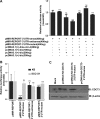Oncogenic microRNA-155 down-regulates tumor suppressor CDC73 and promotes oral squamous cell carcinoma cell proliferation: implications for cancer therapeutics
- PMID: 23166327
- PMCID: PMC3537059
- DOI: 10.1074/jbc.M112.425736
Oncogenic microRNA-155 down-regulates tumor suppressor CDC73 and promotes oral squamous cell carcinoma cell proliferation: implications for cancer therapeutics
Abstract
The CDC73 gene is mutationally inactivated in hereditary and sporadic parathyroid tumors. It negatively regulates β-catenin, cyclin D1, and c-MYC. Down-regulation of CDC73 has been reported in breast, renal, and gastric carcinomas. However, the reports regarding the role of CDC73 in oral squamous cell carcinoma (OSCC) are lacking. In this study we show that CDC73 is down-regulated in a majority of OSCC samples. We further show that oncogenic microRNA-155 (miR-155) negatively regulates CDC73 expression. Our experiments show that the dramatic up-regulation of miR-155 is an exclusive mechanism for down-regulation of CDC73 in a panel of human cell lines and a subset of OSCC patient samples in the absence of loss of heterozygosity, mutations, and promoter methylation. Ectopic expression of miR-155 in HEK293 cells dramatically reduced CDC73 levels, enhanced cell viability, and decreased apoptosis. Conversely, the delivery of a miR-155 antagonist (antagomir-155) to KB cells overexpressing miR-155 resulted in increased CDC73 levels, decreased cell viability, increased apoptosis, and marked regression of xenografts in nude mice. Cotransfection of miR-155 with CDC73 in HEK293 cells abrogated its pro-oncogenic effect. Reduced cell proliferation and increased apoptosis of KB cells were dependent on the presence or absence of the 3'-UTR in CDC73. In summary, knockdown of CDC73 expression due to overexpression of miR-155 not only adds a novelty to the list of mechanisms responsible for its down-regulation in different tumors, but the restoration of CDC73 levels by the use of antagomir-155 may also have an important role in therapeutic intervention of cancers, including OSCC.
Figures






Similar articles
-
MicroRNA-125a reduces proliferation and invasion of oral squamous cell carcinoma cells by targeting estrogen-related receptor α: implications for cancer therapeutics.J Biol Chem. 2014 Nov 14;289(46):32276-32290. doi: 10.1074/jbc.M114.584136. Epub 2014 Sep 29. J Biol Chem. 2014. Retraction in: J Biol Chem. 2019 Apr 12;294(15):5811. doi: 10.1074/jbc.W119.008507. PMID: 25266720 Free PMC article. Retracted.
-
Transcriptional repression of tumor suppressor CDC73, encoding an RNA polymerase II interactor, by Wilms tumor 1 protein (WT1) promotes cell proliferation: implication for cancer therapeutics.J Biol Chem. 2014 Jan 10;289(2):968-76. doi: 10.1074/jbc.M113.483255. Epub 2013 Nov 20. J Biol Chem. 2014. PMID: 24257751 Free PMC article.
-
MicroRNA-9 inhibits the proliferation of oral squamous cell carcinoma cells by suppressing expression of CXCR4 via the Wnt/β-catenin signaling pathway.Oncogene. 2014 Oct 16;33(42):5017-27. doi: 10.1038/onc.2013.448. Epub 2013 Oct 21. Oncogene. 2014. PMID: 24141785
-
A review on the importance of miRNA-135 in human diseases.Front Genet. 2022 Sep 6;13:973585. doi: 10.3389/fgene.2022.973585. eCollection 2022. Front Genet. 2022. PMID: 36147505 Free PMC article. Review.
-
MicroRNAs involved in tumor suppressor and oncogene pathways: implications for hepatobiliary neoplasia.Hepatology. 2009 Aug;50(2):630-7. doi: 10.1002/hep.23010. Hepatology. 2009. PMID: 19585622 Free PMC article. Review.
Cited by
-
Circ_0000140 restrains the proliferation, metastasis and glycolysis metabolism of oral squamous cell carcinoma through upregulating CDC73 via sponging miR-182-5p.Cancer Cell Int. 2020 Aug 26;20:407. doi: 10.1186/s12935-020-01501-7. eCollection 2020. Cancer Cell Int. 2020. PMID: 32863766 Free PMC article.
-
Role of miRNAs and their potential to be useful as diagnostic and prognostic biomarkers in gastric cancer.World J Gastroenterol. 2016 Sep 21;22(35):7951-62. doi: 10.3748/wjg.v22.i35.7951. World J Gastroenterol. 2016. PMID: 27672290 Free PMC article. Review.
-
A Feedback Loop between MicroRNA 155 (miR-155), Programmed Cell Death 4, and Activation Protein 1 Modulates the Expression of miR-155 and Tumorigenesis in Tongue Cancer.Mol Cell Biol. 2019 Mar 1;39(6):e00410-18. doi: 10.1128/MCB.00410-18. Print 2019 Mar 15. Mol Cell Biol. 2019. PMID: 30617160 Free PMC article.
-
Salivary level of microRNA-146a and microRNA-155 biomarkers in patients with oral lichen planus versus oral squamous cell carcinoma.BMC Oral Health. 2023 Jun 29;23(1):433. doi: 10.1186/s12903-023-03155-z. BMC Oral Health. 2023. PMID: 37386382 Free PMC article.
-
The in vitro and vivo effects of nuclear and cytosolic parafibromin expression on the aggressive phenotypes of colorectal cancer cells: a search of potential gene therapy target.Oncotarget. 2017 Apr 4;8(14):23603-23612. doi: 10.18632/oncotarget.15377. Oncotarget. 2017. PMID: 28223542 Free PMC article.
References
-
- Shattuck T. M., Välimäki S., Obara T., Gaz R. D., Clark O.H., Shoback D., Wierman M. E., Tojo K., Robbins C. M., Carpten J. D., Farnebo L. O., Larsson C., Arnold A. (2003) Somatic and germ line mutations of the HRPT2 gene in sporadic parathyroid carcinoma. N. Engl. J. Med. 349, 1722–1729 - PubMed
-
- Aldred M. J., Talacko A. A., Savarirayan R., Murdolo V., Mills A. E., Radden B. G., Alimov A., Villablanca A., Larsson C. (2006) Dental findings in a family with hyperparathyroidism. Jaw tumour syndrome and a novel HRPT2 gene mutation. Oral Surg. Oral Med. Oral Pathol. Oral Radiol. Endod. 101, 212–218 - PubMed
-
- Pimenta F. J., Gontijo Silveira L.F., Tavares G. C., Silva A. C., Perdigão P. F., Castro W. H., Gomez M. V., Teh B. T., De Marco L., Gomez R. S. (2006) HRPT2 gene alterations in ossifying fibroma of the jaws. Oral. Oncol. 42, 735–739 - PubMed
-
- Carpten J. D., Robbins C. M., Villablanca A., Forsberg L., Presciuttini S., Bailey-Wilson J., Simonds W. F., Gillanders E. M., Kennedy A. M., Chen J. D., Agarwal S. K., Sood R., Jones M. P., Moses T. Y., Haven C., Petillo D., Leotlela P. D., Harding B., Cameron D., Pannett A. A., Höög A., Heath H., 3rd, James-Newton L. A., Robinson B., Zarbo R. J., Cavaco B. M., Wassif W., Perrier N. D., Rosen I. B., Kristoffersson U., Turnpenny P. D., Farnebo L. O., Besser G. M., Jackson C. E., Morreau H., Trent J. M., Thakker R. V., Marx S. J., Teh B. T., Larsson C., Hobbs M. R. (2002) HRPT2, encoding parafibromin, is mutated in hyperparathyroidism. Jaw tumour syndrome. Nat. Genet. 32, 676–680 - PubMed
Publication types
MeSH terms
Substances
LinkOut - more resources
Full Text Sources
Other Literature Sources
Medical
Research Materials

